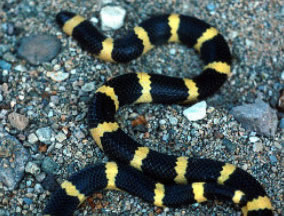Research and Conservation in Southern Sonora, Mexico Sympholis lippiens (Mexican short-tailed snake) by Peter Holm, Ecologist, Organ Pipe Cactus National Monument

Photo: S. A. Meyer |
Sympholis appears to be most closely related to the hooknosed snakes, Gyalopion and Ficimia. However, some aspects of morphology (e.g., fused
prefrontal-internasal) and diet of grubs are similar to Conopsis. Whereas Sympholis is oviparous and inhabits tropical deciduous forest, Conopsis is
viviparous and inhabits montane environments.
Ecological and morphological specializations in Sympholis are
especially exciting. Sympholis is apparently a commensal with the leaf-
cutting ant Atta mexicana and the relationship is significant enough that
it has affected morphological evolution of the snake. Unfortunately, direct
observations of the snake in the ant colonies are few. Merv Larson dug one
out of a chamber in one colony (Schwalbe and Lowe, pers. com.) and I found
one shed skin in a colony detritus mound. I showed a road-killed Sympholis to
two farmers near Alamos, Sonora and asked if they knew where to find them.
Both referred to the snakes as “corralillos”, a common term for coral and
other banded snakes, and both said that they were found with “mochomos”, a
local term for Atta mexicana.
Additional indirect evidence includes the presence of Atta as well as
Coleoptera larvae in the digestive tract of Sympholis. The Coleoptera
larvae are cetoniines, Cotinus and/or Euphoria (Lawler and Van Devender,
1996). I found these grubs to be abundant in the detritus mounds of all Atta colonies, examined even during the dry season when searches under
rocks, logs, and leaf litter produced no other larvae. Atta in the
digestive tracts of Sympholis may be incidental but I found two specimens
with many ants each, suggesting that snakes could occasionally gorge
themselves on Atta. Such a foraging strategy periodically exposes the snake
to large quantities of small prey might favor a longer body. Indeed, Sympholis has a higher ventral scale count and is more massive than any
other sonorinine.
Sympholis is unique among sonorinines by its combination of large
size and highly fossorial morphology. Although the fossorial morphology
would facilitate penetration of the detritus mounds in search of beetle
larvae, it may also help to repel attacks by ants. The tiny eye, rounded
snout, and blunt tail could prevent ants from biting the snake. Sympholis have a tough skin that is difficult to puncture with a needle and may
protect it from bites or stings by ants. Finally, live Sympholis have an"oily" skin that may repel ants as well as an abundance of lipid reserves
that produce unusual blobs in jars of preserved specimens.
Other squamates known to be associated with ants include Leptotyphlops spp., Typhlops spp., and Amphisbaena alba. Watkins et al.
(1967) found Leptotyphlops dulcis to follow the pheromone trails of army
ants. Leptotyphlops dulcis is associated with ant and termite colonies, it
feeds on ant brood and termites, and its cloacal secretions repel ants
(Watkins et al. 1969). Like Sympholis, Leptotyphlops has a rounded head and
blunt tail. The eye is reduced even further and is vestigial. Curiously, Typhlops means “blind”, whereas the specific epithet of Sympholis lippiens means “dim-sighted”. Unlike Sympholis, Leptotyphlops is very slender and is probably more dependent on existing tunnels rather than active burrowing.
Riley et al. (1986) described Amphisbaena alba as a facultative
inquiline of nests of Atta cephalotes in Trinidad. They found specimens in Atta nests, Atta in the digestive tract, and demonstrated that Amphisbaena alba can
follow Atta pheromones. Although A. alba feeds primarily on beetle larvae,
it will take alate pupae of Atta when available but is not immune to
attacks by workers (Riley et al. 1986). It would be interesting to see if Sympholis can follow ant pheromone trails like Leptotyphlops dulcis and Amphisbaena alba.
It is likely that Sympholis not only exploits the abundant prey in
the detritus mounds but also utilizes the stable microclimate and
protection in underground chambers of the ant colony. Snakes, including Zamenis and Naja, and lizards use termite mounds as refuge from flood, drought, and wildfire in savanna forests of Cambodia (Wharton 1966). Seven
species of snakes and one lizard use the fungal chambers of Acromyrmex in
Uruguay as nest sites (Vaz-Ferreira et al. 1970). |